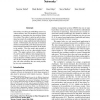Free Online Productivity Tools
i2Speak
i2Symbol
i2OCR
iTex2Img
iWeb2Print
iWeb2Shot
i2Type
iPdf2Split
iPdf2Merge
i2Bopomofo
i2Arabic
i2Style
i2Image
i2PDF
iLatex2Rtf
Sci2ools
DMSN
2004
ACM
2004
ACM
Confidence-based data management for personal area sensor networks
The military is working on embedding sensors in a "smart uniform" that will monitor key biological parameters to determine the physiological status of a soldier. The soldier's status can only be determined accurately by combining the readings from several sensors using sophisticated physiological models. Unfortunately, the physical environment and the low-bandwidth, push-based personal-area network (PAN) introduce uncertainty in the inputs to the models. Thus the model must produce a confidence level as well as a physiological status value. This paper explores how confidence levels can be used to influence data management decisions. In particular, we look at power-efficient ways to keep the confidence above a given threshold. We also contrast push-based broadcast schedules with other schedules that are made possible by two-way communication.
Confidence Levels | DMSN 2004 | Physiological Status | Sensor Networks | Sophisticated Physiological Models |
| Added | 20 Aug 2010 |
| Updated | 20 Aug 2010 |
| Type | Conference |
| Year | 2004 |
| Where | DMSN |
| Authors | Nesime Tatbul, Mark Buller, Reed Hoyt, Steve Mullen, Stanley B. Zdonik |
Comments (0)

